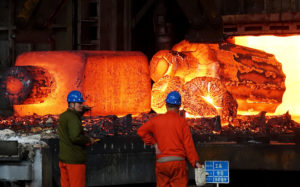At the start of 2020, environmentalists were looking forward to a climate and environment “super year”. But doubts were soon sown as the Covid-19 pandemic forced the postponement of both the Kunming biodiversity conference and the Glasgow climate conference.
But despite the pandemic – and to some extent because of it – the year proved more positive than many predicted.
The disruption and uncertainty caused by Covid have forced both China and the rest of the world to rapidly reshape their response to climate change. New concepts and ideas stirred up by the health crisis have helped us break free from old ways of thinking and existing methodologies, offering new hope for climate action this year.
As such, although it didn’t turn out to be a super year, it was certainly a critical one.
1: ‘The environmental and health crisis’
The onset of Covid-19 and its links to the trade in wild animals sparked a rethinking of how humanity coexists with the rest of nature. Meanwhile, the climate crisis did not stop because of the pandemic, with extreme weather events over the summer gaining a lot of attention. Overlapping in time, it’s become clear that the two crises share a common cause: the lack of balance in the human-nature relationship.
This was highlighted in a July report from the UN Environmental Programme and the International Livestock Research Institute, which described climate change as a driver of epidemics, and, just like zoonotic diseases, a consequence of the overexploitation of natural resources. To have the best chance of preventing another pandemic, we need to address climate and infectious diseases simultaneously.
Indeed, strengthening the link between health and climate, rather than treating the two crises separately, has been an emerging theme of the climate narrative this year. This has also helped raise awareness of climate issues among the general public.
2020 saw the idea of nature-based solutions taken more seriously as an important route to tackling climate change, thanks to the emphasis these approaches place on the coexistence of humanity and the rest of nature. Such solutions include the restoration of wetlands and forests, sustainable agriculture and the building of “sponge cities” to mitigate flooding. They were frequently mentioned in discussions about recovering from the pandemic, due to their focus on improving the resilience both of society and ecosystems. Also in 2020, the Chinese government published its plan for major ecosystem protection and restoration projects in 2021-2035, adding national policies backing the goal of ecosystem restoration. Nature-based solutions are expected to be made greater use of under this framework.
2: ‘China’s carbon neutrality pledge’
At the beginning of 2020, hardly anyone would have predicted that China would commit to peak carbon before 2030 and carbon neutrality before 2060. The announcement, made at the UN General Assembly in September, boosted climate ambition globally, and similar promises were subsequently heard around the world, with Japan, South Korea and other nations committing to carbon neutrality by mid-century.
Beyond China’s borders, the announcement drew applause and affirmation. At home, that piece of “foreign news” – as climate change tends to be categorised – has become a new national goal that policymakers must somehow find ways to achieve. Ambitious new targets are now expected in the 14th Five Year Plan, currently being drafted, indicating climate change is a more important part of the country’s political and economic strategies than ever before. Meanwhile, it has narrowed the gap between China and the rest of the world when it comes to acknowledgement of the urgency of the issue – now no longer seen as a distant foreign matter. Carbon neutrality by 2060 is on the agenda for all sectors in China, and the effects of this will continue to be felt for some time.
China’s elevated climate role following its carbon neutrality pledge also means that the quality and consistency of its climate ambitions will be subject to harsher scrutiny. There are already hopes that China will go beyond the scope of its own nationally determined contributions to combatting climate change. Indices such as added coal-power capacity for 2020, coal power and carbon emissions targets in the 14th Five Year Plan, and the carbon footprint of overseas energy investments will all be seen as tests for that leadership role.
3: ‘The green recovery’
As the world struggled with coronavirus during March and April, the idea of “building back better” came into play. By the end of 2020, both the European Union and the United Kingdom had released recovery plans with green elements – and the necessary funding.
But China’s stimulus policies lacked any green framework, leaving observers trying to spot the good news. Local and central government bonds played a key role in a rapid recovery, but experts worry China is still taking an outdated approach to boosting the economy.
Will 2021 see China find a route to recovery that does not rely on increased carbon emissions? This should be considered within the wider context of China’s economic rebalancing. The pandemic recovery measures reflect pre-existing imbalances: industry recovered quickly, but growth only returned to the retail and service sectors in the third quarter of 2020. In addition, low-income groups and less-developed regions were hit harder by coronavirus, and recovered more slowly. China has already realised that investment in public infrastructure has become a less effective way of stimulating the economy, and policymakers have time and again stressed the importance of sustainable and inclusive growth. Green elements will be indispensable during deeper structural reforms and efforts to create a more balanced, inclusive and vigorous economy.
2021: a new starting line
The ongoing battle against the Covid-19 pandemic has shown us there are no easy answers to this global crisis; it is necessary to break free of old ideas and limitations. The measures many governments have taken – widespread lockdowns, huge financial relief packages, increased deficits – have proven that things once considered impossible can actually be done. The climate crisis will require policymakers to show the same resolve to break established patterns.
China’s pledge on carbon neutrality may mean a climate breakthrough is on the way. Here’s what we can look forward to for action on climate change during 2021:
- Changes in governance resulting from the intersection of climate and health issues
As climate change worsens and its impact on healthcare systems gets more attention, there is hope that climate will become a larger factor in health policy. With China attempting to build a more resilient healthcare system, this provides an opportunity to address both the health and environmental crises. The pandemic has also prompted a rethinking of intensive industrialised animal farming and the global agriculture supply chain, which has proven highly vulnerable to pandemic-induced disruptions. China’s post-Covid reforms will likely result in the reorganisation of the sector in terms of agricultural infrastructure, benefits to farmers and supply-chain diversification, which will have far-reaching impacts on climate and public health.
- Changes arising from China’s carbon neutrality pledge
Key targets for the 14th Five Year Plan period are currently being set. Whatever new goals for emissions reductions and renewable energy capacity are decided upon, they will be challenging – as will the transitions needed in each sector to realise low-carbon production and growth. But since China’s pledge, national carbon markets are now about to start operating, the development of green finance has been repeatedly accelerated, and there are a number of green finance policies to look forward to in 2021.
Internationally, a recently concluded EU–China deal on investment includes commitments to cooperate on the environment and climate, with an emphasis on sustainable development principles – a clear indication the two sides will cooperate globally on climate change. It remains to be seen if the issue will provide a breakthrough in China–US relations once the United States rejoins the Paris Agreement under the Biden administration. But China’s early commitment on carbon neutrality has shown good faith and laid a foundation for multilateral climate cooperation.
- A green recovery
The Chinese economy could make a full recovery in 2021, with growth of 8% expected. When speaking to the UN General Assembly on 22 September, President Xi Jinping used the phrase “green recovery” for the first time, indicating that this concept may gain more concrete policy support during 2021, especially in connection with the carbon neutrality goal. Also, international green recovery policies and trends – such as economic recovery packages that include limits on funding for polluting projects – may start to be seen in China.
Correction notice: The original version of this article stated that China had committed to peaking its carbon emissions by 2030 and reaching carbon neutrality by 2060. On 21 January 2025, this was corrected to before 2030 and before 2060.







![The four person medical team at Kwaring village of Lahaul tests for Covid-19 during winter in the high Himalayas [Image by: Rakesh Parihar]](https://dialogue.earth/content/uploads/2021/02/Photo_5_Kwaring-2048x1375-1-300x201.jpg)

![Woman farmer carrying her child while cutting rice crops from the field, in village Qasim Solangi, Hyderabad [image by: Manoj Genani]](https://dialogue.earth/content/uploads/2021/02/Women-peasant-carrying-her-child-while-cutting-rice-crops-from-the-field-in-village-Qasim-Solangi-Hyd-2048x1365-1-300x200.jpg)